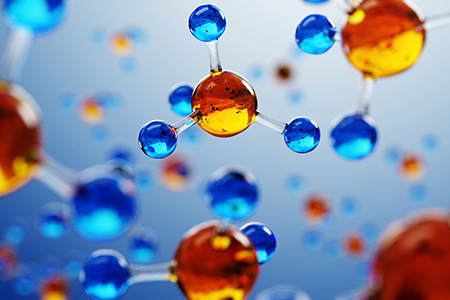 Vitamins are organic molecules that are essential for proper metabolism and bodily function. While they go by different names, most vitamins are actually groups of chemically-related organic molecules known as vitamers1. Some vitamins must be obtained from dietary sources as they are produced in insufficient quantities or are not synthesized by the body at all. Humans have thirteen essential vitamins that must be obtained from dietary sources:
Vitamins are organic molecules that are essential for proper metabolism and bodily function. While they go by different names, most vitamins are actually groups of chemically-related organic molecules known as vitamers1. Some vitamins must be obtained from dietary sources as they are produced in insufficient quantities or are not synthesized by the body at all. Humans have thirteen essential vitamins that must be obtained from dietary sources: The Thirteen Essential Vitamins
| Vitamin A (Retinoids and Carotene) | Vitamin B6 (Pyridoxine) | Vitamin D (Calciferol) |
| Vitamin B1 (Thiamin) | Vitamin B7 (Biotin) | Vitamin E (Alpha-tocopherol) |
| Vitamin B2 (Riboflavin) | Vitamin B9 (Folic Acid) | Vitamin K (Phylloquinone, Menadione) |
| Vitamin B3 (Niacin) | Vitamin B12 (Cobalamin) | |
| Vitamin B5 (Pantothenic Acid) | Vitamin C (Absorbic Acid) |
Vitamin Deficiencies and Overdoses
Vitamin D
Vitamin D is a hormone that aids in calcium absorption. Without it, bones are not able to form correctly.Vitamin D Deficiency
In the 20th century, rickets was a very common condition caused by vitamin D deficiency. This condition usually manifested within the first few years of life resulting in stunted growth and bone malformities.In the 1930s, major food manufacturers began to supplement milk with vitamin D to combat the rickets public health crisis1. While this condition is not as prevalent today, it is still present in areas with childhood malnutrition and limited access to the necessary medical interventions.
Reduced sun exposure can also result in a slight vitamin D deficiency when there is not enough supplemental vitamin D in the diet. This condition is commonly seen in Northern countries where the sun is not very strong most of the year. Prolonged vitamin D deficiency is a risk factor for the development of chronic disease and overall mortality2.
Vitamin D Overdose
Vitamin D is fat soluble. Over-supplementation of this vitamin is not recommended, as a vitamin D buildup in fat cells can cause hypercalcemia, which is a dangerous buildup of calcium in the blood3.Vitamin C
Vitamin C is essential for the development and maintenance of connective tissues (e.g., collagen, cartilage, bones, and teeth). Additionally, it supports the immune system as well as protects the body from damage due to free radical species by functioning as an antioxidant6.Vitamin C Deficiency
Scurvy is the result of a vitamin C deficiency that has been apparent amongst sea travelers since the 15th century. The main sources of vitamin C during this time period were fresh fruits and vegetables — none of which were available on multiple month-long journeys while at sea. In the earliest stages, scurvy presents itself as joint pain, under-skin blood spots, and bad breath. As the disease progresses, afflicted people would experience pain too intense to walk and eventually sudden death due to rupturing of the blood vessels4.Vitamin C Overdose
Unlike the fat-soluble vitamin D, over-supplementation of the water-soluble vitamin C does not cause any short-term or long-term harm as it is easily excreted from the body. The role of vitamin solubility will be discussed in depth shortly.Vitamin A
Vitamin A is important for maintaining immune function, vision, and cellular communication.Vitamin A Deficiency
A lack of vitamin A is common in regions of the world where access to proper nutrition is not available. Since vitamin A is involved in maintaining immune function, vision, and cellular communication, a Vitamin A deficiency can cause blindness, infertility, stunted growth, and poor wound healing5.Vitamin A Overdose
Much like vitamin D, too much vitamin A can cause dangerous side effects. Vitamin A is fat-soluble and stored in the liver, where the buildup of this compound can cause vision changes, bone swelling, birth defects, and neurological problems6.Importance of Vitamin Solubility
Vitamins are either fat-soluble or water-soluble. The fat-soluble vitamins (A, D, E, and K) are readily stored in adipose tissue or the liver and can, therefore, accumulate in excess amounts if not metabolized. This accumulation can damage the liver, as well as lead to hypervitaminoses and toxic symptoms.In contrast, water-soluble vitamins must be regularly ingested because they are not stored in the body. These vitamins (8 B vitamins and vitamin C) can be ingested in very high quantities without contributing to toxicity.
The Food and Nutrition Board of the Institute of Medicine at the National Academy of Sciences issues guidelines for the Recommended Dietary Allowance (RDA) of a variety of nutrients including vitamins. Along with the RDA, an Adequate Intake (AI) and Tolerable Upper Intake Level (UL) are also established to ensure nutritional sufficiency and prevent adverse health effects.
















.jpg)

.jpg)
.jpg)
.jpg)
.jpg)





.jpg)


.jpg)
.jpg)




.jpg)




.jpg)

.jpg)



